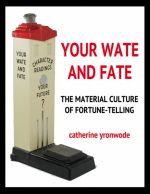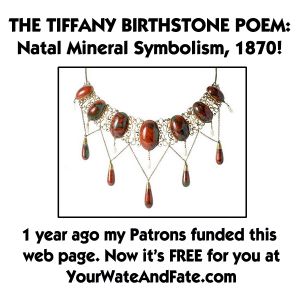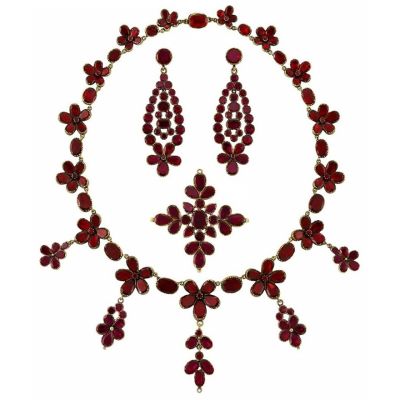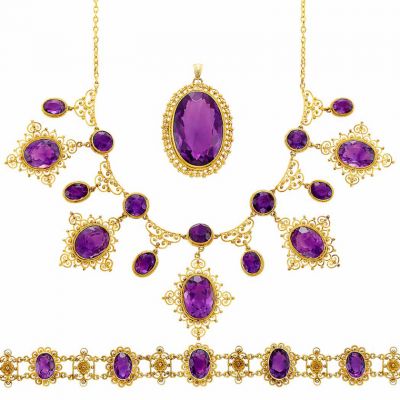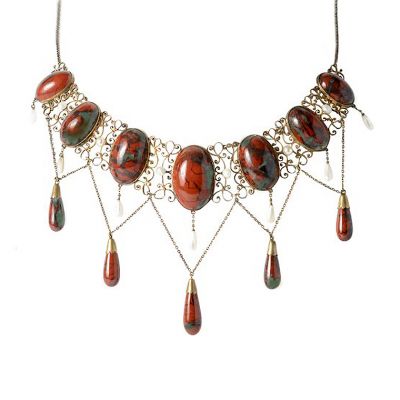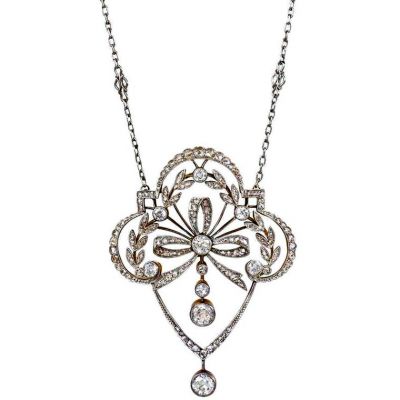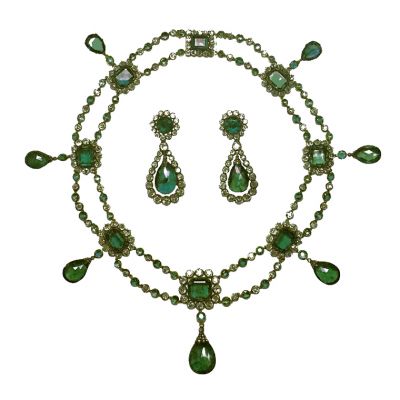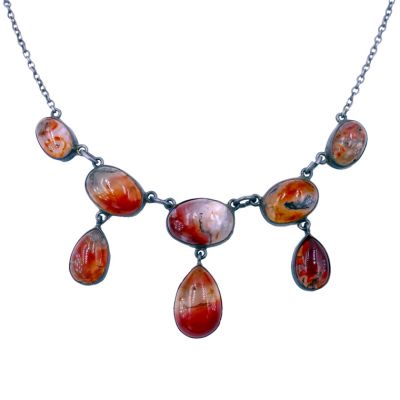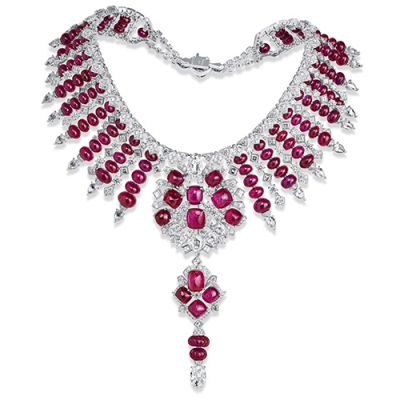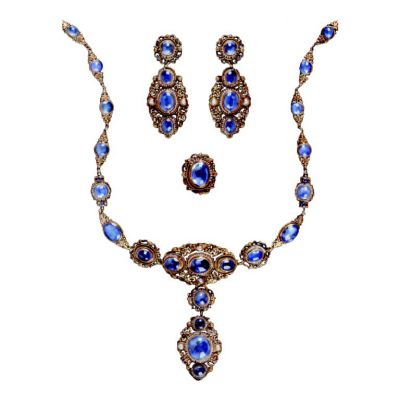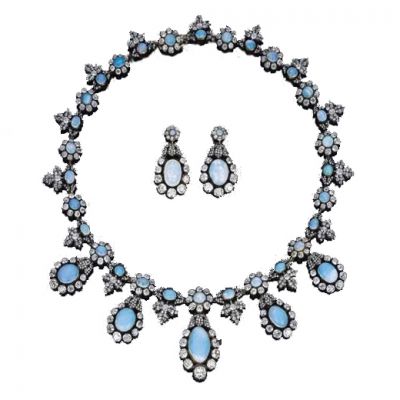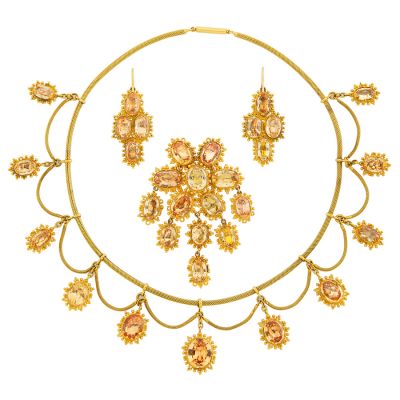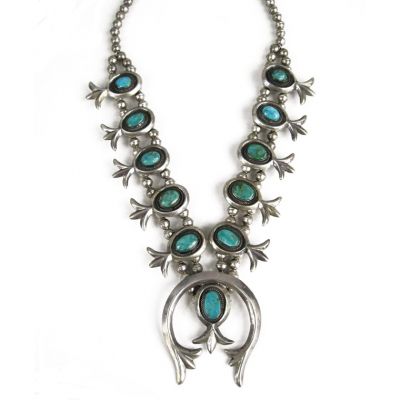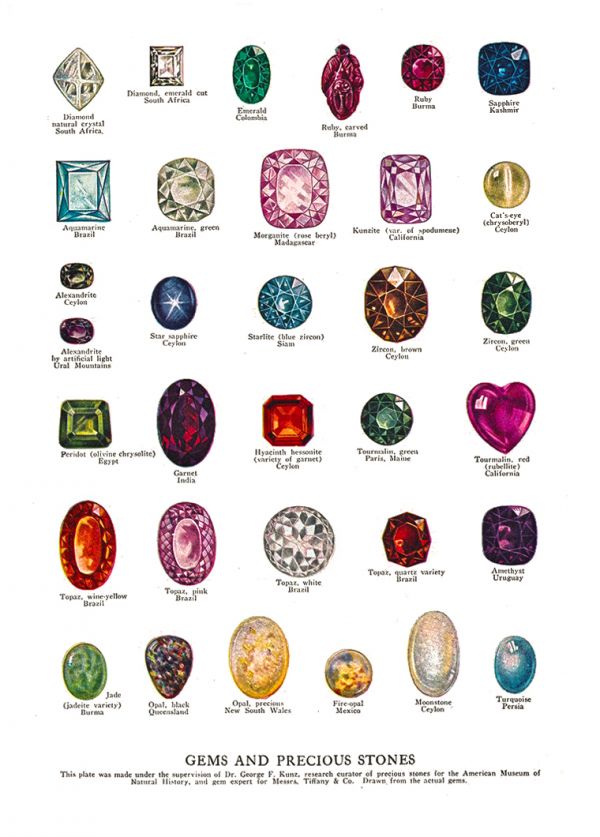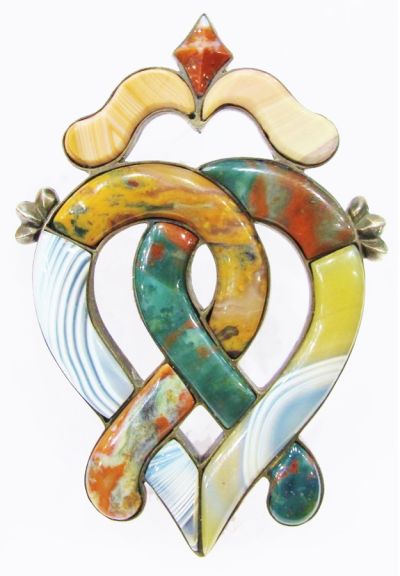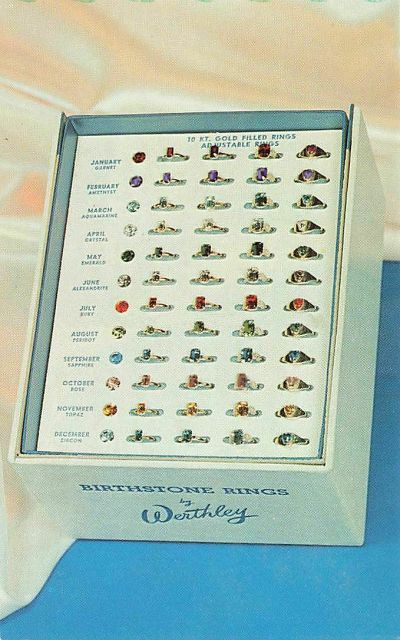The Tiffany Birthstone Poem
My Patreon supporters paid for this page and had access to it one full year before the public did.
- Patreon Release Date: February 21st, 2021
- Public Release Date: February 21st, 2022.
Please tell your friends that they can subscribe to my Patreon stream for $2.00 per week:
Patrons: To discuss this and other Patreon pages with me, join my private Patreon Forum:
Support Your Wate and Fate
All of the material you have access to here -- the instructive booklets, the nostalgic postcards, the boldly graphic ephemera, and all of the historical information researched and shared from the mind of the woman who is making it all happen -- can easily fit into one 8 x 10 foot room in an old Victorian farmhouse, but you would never see it without the investment of the time it takes to produce such a site and the caloric input such a site requires in the form of food for the writer, graphic designer, and database manager, as well as the US currency needed to pay for the computers, software applications, scanners, electricity, and internet connectivity that bring it out of that little room and into the world.
So, as you can see, this site is the darling of many, and it is growing at a rapid rate ... but although it is "free," there also is a cost. The financial support of my Patreon subscribers -- my Patrons -- underwrites this cost.
The Tiffany Birthstone Poem
The Tiffany Birthstone Poem, also known as The Gregorian Birthstone Poem is an anonymous series of 12 short verses, each four lines long, that attribute one magically lucky birthstone to each month of the year. It was printed in a pamphlet by Tiffany and Co., a fine jewelry store, in 1870, presumably to encourage the sales of birthstone jewelry. The word "Gregorian" in the title is not explained; it seems to allude to an older era of Gregorian monks and pre-Raphaelite aesthetics, matching the poetical form, which is deliberately antiquated. In keeping with its supposed antiquity, it had no attribution, and seems not to have been copyrighted.
What follows is my best attempt to reconstruct the original form of the poem. I have illustrated each month with jewelry of the named stone. Many of these pieces are antique and vintage parures or sets. For those unfamiliar with fine jewelry, a full parure is a set of matching jewelry that typically comprises a necklace, earrings, a brooch, a bracelet, and a ring, while a demi-parure may consist of a necklace and a pair of earrings. The most elaborate parures, made for the female members of noble or royal families, might include a second matching bracelet and ring and well as a tiara or diadem.
Thanks to my Patron Kristina Bailey for bringing The Tiffany Birthstone Poem to my attention.
JANUARY
"By her who in this month was born
No gem save Garnets shall be worn
They will ensure her constancy,
True friendship, and fidelity."
FEBRUARY
"The February born shall find
Sincerity and peace of mind,
Freedom from passion and from care,
If they the Amethyst will wear."
MARCH
"Who in this world of ours their eyes
In March first open shall be wise,
In days of peril firm and brave
And wear a Bloodstone to the grave."
APRIL
"She who from April dates her years
Diamonds should wear, lest bitter tears
For vain repentance flow; this stone,
Emblem of innocence is known."
MAY
"Who first beholds the light of day
In Spring's sweet flowery month of May
And wears an Emerald all her life
Shall be a loved and a loving wife."
JUNE
"Who comes with summer to this earth,
And owes to June her hour of birth,
With ring of Agate on her hand
Can health, wealth, and long life command."
JULY
"The glowing Ruby shall adorn
All those who in July are born,
For thus they'll be exempt and free,
From love’s doubts and anxiety."
AUGUST
"Wear Sardonyx or for thee,
No conjugal felicity;
The August-born without this stone,
'Tis said, must live unloved and lone."
SEPTEMBER
"A maiden born when autumn leaves
Are rustling in September's breeze,
A Sapphire on her brow should bind;
'Twill cure diseases of the mind."
OCTOBER
"October's child is born for woe,
And life's vicissitudes must know,
But lay an Opal on her breast,
And hope will lull those woes to rest."
NOVEMBER
"Who first comes to this world below
With drear November's fog and snow,
Should prize the Topaz amber hue,
Emblem of friends and lovers true."
DECEMBER
"If cold December gave you birth
The month of snow and ice and mirth
Place on your hand a Turquoise blue;
Success will bless whate'er you do."
The Poem Meets the Folk Process
The verses of this poem follow the familiar sing-song pattern i call "the English Enchantment." Dating back at least to the Renaissance and the writing of William Shakespeare, such verses are found to this day in the metrical magical spells of the Anglo-Saxon people. The same scansion, with a variety of wordings, is found on many fortune telling tea cups, as seen at our sister-site, The Mystic Tea Room in the page about Poetry on Cups and Saucers.
Thirty-five years after its first publication, when the chromolithographic postcard craze took off in 1905, the Tiffany Birthstone Poem was considered to be in the public domain, and thus it formed the basis for many of the Birthstone postcard texts, even those that do not contain the full four lines per card, but make do instead with a mere rhymed couplet.
In the hands of a variety of English and American postcard publishers, the text was muddled by other anonymous authors, either in an attempt to modernize it or to change the moral tone attributed to the months.
- January's judgmental assurance of "fidelity" became the much sweeter-sounding invitation to "felicity."
- The old-fashioned "drear November" became, to some, "dreary November," breaking the meter.
- The May-born woman who "wears an Emerald all her life" to "be a loved and a loving wife" became those people who "wear an Emerald on their breast" to "be beloved, happy and blessed," which messed with the meter but had the virtue of being gender-free.
- The rather ominous advice that the September-born maiden,
A Sapphire on her brow should bind;
'Twill cure diseases of the mind
became the comfortably cheerful
A Sapphire on her brow should bind;
To bring her joy and peace of mind.
The Poem Meets The High-End-Jewelers
The Tiffany Birthstone poem was, as noted, composed in a way to make it sound old-fashioned or antique, even when it was new. The twelve stones that were selected comprised a heterodox assortment of those found in the Bible, in Shakespeare's plays, and in old books on magical correspondences, such as the works of Pliny and Agrippa. Most of these stones were available in the form of finished jewelry from Tiffany & Co. of New York City, and the company also prepared a convenient encyclopedia illustration showing some of the varieties available. The plate's caption reads: "This chart was made under the supervision of Dr. George F. Kunz, research curator of precious stones for the American Museum of Natural History, and gem expert for Messrs. Tiffany & Co. Drawn from the actual gems."
Dr. George Frederick Kunz (1856 –1932) was the foremost American mineralogist of his era and is best known today as the author of the definitive 1913 book "Curious Lore of Precious Stones: Being a Description of their Sentiments and Folk Lore, Superstitions, Symbology, Mysticism, Use in Medicine, Protection, Prevention, Religion, and Divination, Crystal Gazing, Birth Stones, Lucky Stones and Talismans, Astral, Zodiacal and Planetary." This book remains in print to the present time. It is out of copyright and is thus also available online in digital form, but be aware that the beautiful colour plates are generally reduced to muddy black-and-white hash in reprint editions. It is worth going without lunch for four months or taking on an extra freelance job in order to buy a first edition copy in fine condition. I speak as one who has done so, twice.
Now, back to the poem. Some of the stones mentioned were rare, precious, translucent gemstones. These were generally facet-cut and colour-matched, and only the wealthy could afford a full parure or set of them.
- Diamond
- Emerald
- Ruby
- Sapphire
- Topaz
Some were common, semi-precious, translucent gemstones. These were generally facet-cut and colour-matched, but the upper-middle-class could afford them.
- Amethyst
- Garnet
Some were common, opaque or semi-opaque figured stones. These were generally cut as cabochons, used for cameo or intaglio engraving, or carved and fitted together to create patchwork patterns, and even the lower-middle-class could at least afford one in a ring or pendant.
- Agate
- Bloodstone
- Opal
- Sardonyx
- Turquoise
Sardonyx had a run of several decades of popularity in the carving of cameos, but when Italian carvers flooded the market with shell cameos during the late 19th and early 20th century, the more expensive Sardonyx cameos fell out of favour.
Turquoise, always a bit exotic and rare, albeit unreliable in its colour stability, hit new highs of popularity when its use in Navajo silver-smithing was placed before the American public during the 1910s, and has remained consistently popular due to its historical connection to the American Southwest.
In this group of common mineral specimens, the Agate and Bloodstone were old fashioned, heavy and mostly opaque subjects. Agate was, and is, a dime-a-dozen rock, and Bloodstone is nothing more than a very fancy form of Jasper -- so as beautiful as individually figured pieces may be, they are casual stones, not easily colour-matched. The reason Agate may have been included in the Tiffany Birthstone Poem is that during the latter half of the reign of Queen Victoria, a cultural fad arose for all things Scottish. The Queen wore tartans at her castle in Balmoral, and Scotland became a tourist destination for the nobility and the middle-class alike, complete with hand-crafted artisanal souvenir jewelry to purchase as a memento of one's visit to the Highlands.
The splendid workmanship of "Scottish pebble jewelry," made by fitting together naturally banded, moss, and spotted Agates and Jaspers, was considered a national treasure (and, in retrospect, so it was). Using techniques similar to marquetry, Scottish jewelers crafted wonderful patchwork circles, ovals, crests, and other flat decorative pieces, and also produced dimensional serpents, twisted ropes, and luckenbooth brooches set into silver. The luckenbooth, a symbol comprised of an openwork heart-form surmounted by a crown-form, was a favourite when crafted in sterling silver as well as in Agate, because it symbolizes love. Giving a young woman a piece of luckenbooth jewelry was equivalent to giving her what is now called a "promise ring" -- not quite a contract of betrothal, engagement, or marriage, but a significant symbol of committed love. However, when Sottish Agate-work or pebble jewelry went out of style, the jewelers moved on to new commercial fields.
In making their shifts from the old to the new, from the common to the precious, from the opaque to the translucent, high-end jewelers tinkered with the list of birthstones, and thus with the Tiffany Birthstone Poem.
- Over the years June's humble Agate fell out of favour, to be replaced with the more costly Pearls -- which, alas, breaks the poem's scansion, unless one is in the habit of pronouncing "Pearls" as "Per'-uls."
- Some jewelers took themselves even farther, naming June's stone as Alexandrite, which, although expensive and lovely, does not fit the meter of the verse at all.
- Likewise, the old-fashioned Sardonyx of August was, by some jewelers, replaced with Peridot, which, although it has the correct number of syllables, places the stress on a different syl-LAB-le.
The Dime Store Birthstone Ring
When high-end jewelers promoted their systematized magical ascriptions for artisanal and amuletic birthstone jewelry, they were working from historical models. The jewelry they produced, even when crafted from low-end stones, was considered a thoughtful or even devotional gift with strong magical resonances. However, during the 20th century, after two world wars, the birthstone ring became a cheap and simple present, something cute to give to a young girl about whom you knew very little except the month in which she was born. This deprecation of birthstone jewelry led to the creation of the dime store birthstone ring.
Dime store jewelers could not afford to utilize rarities like Diamonds or temperamental stones like Opal or Turquoise. To accomplish their goal -- a cheap birthstone ring for every teenaged girl in America -- they changed the stones radically. In the post-war set of ascriptions, economy set the tone, but no opaque stones were permitted, for sparkle was the name of the game and a tiny chip of a precious gem would do the trick.
- For March, Aquamarine replaced Bloodstone.
- For April, Crystal (meaning clear Quartz) replaced Diamond.
- For June, Alexandrite replaced Agate (or the earlier replacement, Pearls)
- For August, Peridot replaced Sardonyx
- For October, Rose (meaning Rose Quartz) replaced Opal
- For December, Zircon replaced Turquoise.
On the back of the 1950s Werthly advertising postcard we see that the chipboard counter-top box is self-stocking, with drawers of replacement rings at the ready to fill the empty places as these 10k gold-filled trinkets are sold.
Alas, with all these changes to the gemstone list, the mnemonic and symbolic value of the old Tiffany Birthstone poem was no more ... and thus it faded into history.
catherine yronwode
curator, historian, and docent
Your Wate and Fate
Special thanks to my dear husband and creative partner nagasiva yronwode for illustrations, scans, and clean-ups.
